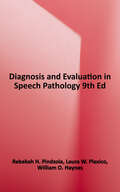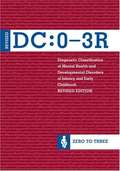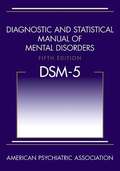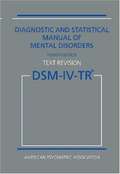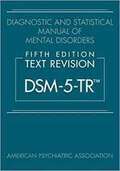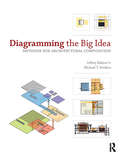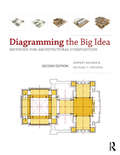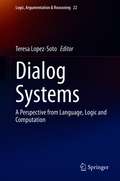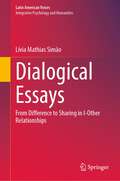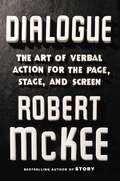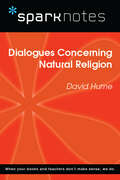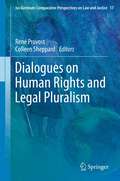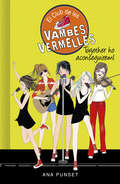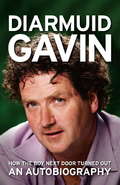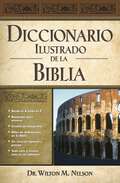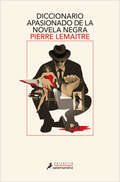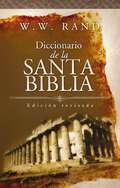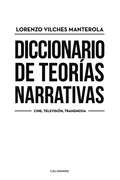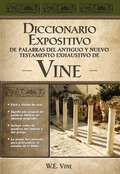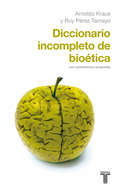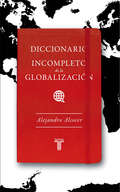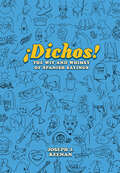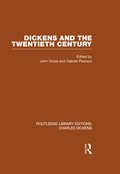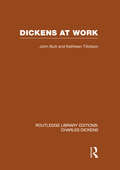- Table View
- List View
Diagnosis and Evaluation in Speech Pathology , Ninth Edition
by William O. Haynes Rebekah H. Pindzola Laura W. PlexicoDiagnosis and Evaluation in Speech Pathology presents practical, useful assessment issues and tips on specific speech-language-swallowing disorders; provides flexible ways to assess the disorders through both standardized and non-standardized appraisal; and guides readers’ attention through a wide variety of learning tools, including new assessment materials available commercially through research publications and via social media, learning objectives and self-assessment questions for each chapter, and concluding remarks that wrap up the information covered. The material also aids the clinician with accountability to third-party payors. The new Ninth Edition of Diagnosis and Evaluation in Speech Pathology has been updated throughout and includes a new chapter on adult dysphagia and pediatric feeding and swallowing disorders; a new chapter on issues of head and neck cancer and laryngeal speech rehabilitation; a revised chapter on report writing; current clinical insights into diagnosing and evaluating communications disorders, and two new Appendices, one showing how to conduct oral peripheral examinations and the other presenting standard reading passages, which can be used in various types of assessment.
Diagnostic Classification of Mental Health and Developmental Disorders of Infancy and Early Childhood (Revised)
by Zero To Three StaffZERO TO THREE'S Diagnostic Classification of Mental Health and Developmental Disorders of Infancy and Early Childhood (DC:0-3), published in 1994, was designed to address the need for a systematic, developmentally based approach to the classification of mental health and developmental difficulties in the first 4 years of life.
Diagnostic and Statistical Manual of Mental Disorders, (DSM-5), 5th edition
by American Psychiatric AssociationThis new edition of Diagnostic and Statistical Manual of Mental Disorders (DSM-5®), used by clinicians and researchers to diagnose and classify mental disorders, is the product of more than 10 years of effort by hundreds of international experts in all aspects of mental health. Their dedication and hard work have yielded an authoritative volume that defines and classifies mental disorders in order to improve diagnoses, treatment, and research. The criteria are concise and explicit, intended to facilitate an objective assessment of symptom presentations in a variety of clinical settings -- inpatient, outpatient, partial hospital, consultation-liaison, clinical, private practice, and primary care. New features and enhancements make DSM-5® easier to use across all settings: • The chapter organization reflects a lifespan approach, with disorders typically diagnosed in childhood (such as neurodevelopmental disorders) at the beginning of the manual, and those more typical of older adults (such as neurocognitive disorders) placed at the end. Also included are age-related factors specific to diagnosis. • The latest findings in neuroimaging and genetics have been integrated into each disorder along with gender and cultural considerations. • The revised organizational structure recognizes symptoms that span multiple diagnostic categories, providing new clinical insight in diagnosis. • Specific criteria have been streamlined, consolidated, or clarified to be consistent with clinical practice (including the consolidation of autism disorder, Asperger's syndrome, and pervasive developmental disorder into autism spectrum disorder; the streamlined classification of bipolar and depressive disorders; the restructuring of substance use disorders for consistency and clarity; and the enhanced specificity for major and mild neurocognitive disorders). • Dimensional assessments for research and validation of clinical results have been provided. • Both ICD-9-CM and ICD-10-CM codes are included for each disorder, and the organizational structure is consistent with the new ICD-11 in development. The Diagnostic and Statistical Manual of Mental Disorders, Fifth Edition, is the most comprehensive, current, and critical resource for clinical practice available to today's mental health clinicians and researchers of all orientations. The information contained in the manual is also valuable to other physicians and health professionals, including psychologists, counselors, nurses, and occupational and rehabilitation therapists, as well as social workers and forensic and legal specialists.
Diagnostic and Statistical Manual of Mental Disorders, (DSM-IV), 4th edition
by American Psychiatric AssociationSince the DSM-IV was published in 1994, we've seen many advances in our knowledge of psychiatric illness. This Text Revision incorporates information culled from a comprehensive literature review of research about mental disorders published since DSM-IV was completed in 1994. Updated information is included about the associated features, culture, age, and gender features, prevalence, course, and familial pattern of mental disorders. The DSM-IV-TR brings this essential diagnostic tool up-to-date, to promote effective diagnosis, treatment, and quality of care. Now you can get all the essential diagnostic information you rely on from the DSM-IV along with important updates not found in the 1994 edition. Stay current with important updates to DSM-IV-TR TM. Benefit from new research into Schizophrenia, Asperger's Disorder, and other conditions Utilize additional information about the epidemiology and other facets of DSM conditions Update ICD-9-CM codes implemented since 1994 (including Conduct,Disorder, Dementia, Somatoform Disorders) Sections on prevalence, gender/age/culture, course, and familial pattern have also been revised to reflect recent research findings. More comprehensive differential diagnoses have been incorporated for many of the disorders.
Diagnostic and Statistical Manual of Mental Disorders, Text Revision (DSM-5-TR)
by American Psychiatric AssociationThe Diagnostic and Statistical Manual of Mental Disorders, Fifth Edition, Text Revision (DSM-5-TR), is the most comprehensive, current, and critical resource for clinical practice available to today's mental health clinicians and researchers. <p><p>DSM-5-TR includes the fully revised text and references, updated diagnostic criteria and ICD-10-CM codes since DSM-5 was published in 2013. It features a new disorder, Prolonged Grief Disorder, as well as codes for suicidal behavior available to all clinicians of any discipline without the requirement of any other diagnosis. <p><p>With contributions from over 200 subject matter experts, this updated volume boasts the most current text updates based on the scientific literature. Now in four-color and with the ability to authenticate each printed copy, DSM-5-TR provides a cohesive, updated presentation of criteria, diagnostic codes, and text. <p><p>This latest volume offers a common language for clinicians involved in the diagnosis and study of mental disorders and facilitates an objective assessment of symptom presentations across a variety of clinical settings—inpatient, outpatient, partial hospital, consultation-liaison, clinical, private practice, and primary care. <p><p>Stay current with these important updates in DSM-5-TR: • Fully revised text for each disorder with updated sections on associated features, prevalence, development and course, risk and prognostic factors, culture, diagnostic markers, suicide, differential diagnosis, and more.• Addition of Prolonged Grief Disorder (PGD) to Section II—a new disorder for diagnosis• Over 70 modified criteria sets with helpful clarifications since publication of DSM-5• Fully updated Introduction and Use of the Manual to guide usage and provide context for important terminology• Considerations of the impact of racism and discrimination on mental disorders integrated into the text• New codes to flag and monitor suicidal behavior, available to all clinicians of any discipline and without the requirement of any other diagnosis• Fully updated ICD-10-CM codes implemented since 2013, including over 50 coding updates new to DSM-5-TR for substance intoxication and withdrawal and other disorders• Updated and redesigned Diagnostic Classification <p><p>This manual is a valuable resource for other physicians and health professionals, including psychologists, counselors, nurses, and occupational and rehabilitation therapists, as well as social workers and forensic and legal specialists. The new DSM-5-TR is the most definitive resource for the diagnosis and classification of mental disorders.
Diagramming the Big Idea: Methods for Architectural Composition
by Jeffrey Balmer Michael T. SwisherAs a beginning design student, you need to learn to think like a designer, to visualize ideas and concepts, as well as objects. In Diagramming the Big Idea, Jeffrey Balmer and Michael T. Swisher illustrate how you can create and use diagrams to clarify your understanding of both particular projects and organizing principles and ideas. With accessible, step-by-step exercises that interweave diagrams, drawings and virtual models, the authors clearly show you how to compose meaningful and useful diagrams. As you follow the development of the four project groups drawn from the authors’ teaching, you will become familiar with architectural composition concepts such as proportion, site, form, hierarchy and spatial construction. In addition, description and demonstration essays extend concepts to show you more examples of the methods used in the projects. Whether preparing for a desk critique, or any time when a fundamental insight can help to resolve a design problem, this book is your essential studio resource.
Diagramming the Big Idea: Methods for Architectural Composition
by Jeffrey Balmer Michael T. SwisherBecoming an architect is a daunting task. Beyond the acquisition of new skills and procedures, beginning designers face an entirely unfamiliar mode of knowledge: design thinking. In Diagramming the Big Idea, Jeffrey Balmer and Michael T. Swisher introduce the fundamentals of design thinking by illustrating how architects make and use diagrams to clarify their understanding of both specific architectural projects and universal principles of form and order. With accessible, step-by-step procedures that interweave diagrams, drawings and virtual models, the authors demonstrate how to compose clear and revealing diagrams. Design thinking defines a method for engaging the world through observation and analysis. Beyond problem solving, design is a search for possibilities. Mastering design thinking begins with learning the fundamentals of visual composition. It embraces the ability to synthesize deductive and imaginative reasoning, combining both shrewd scrutiny and fevered speculation. Design diagrams make visible the abstractions that order the built environment. Premised upon the Beaux-Arts notion of the architectural parti, Balmer and Swisher adopt the ‘Big Idea’ as a foil and as a suitcase to organize fundamentals of architectural composition. The goal of this book is to make explicit to students what they are learning, why they are learning it and how to internalize such lessons toward their lifelong development as designers.
Dialog Systems: A Perspective from Language, Logic and Computation (Logic, Argumentation & Reasoning #22)
by Teresa Lopez-SotoThis book focuses on dialog from a varied combination of fields: Linguistics, Philosophy of Language and Computation. It builds on the hypothesis that meaning in human communication arises at the discourse level rather than at the word level. The book offers a complex analytical framework and integration of the central areas of research around human communication. The content revolves around meaning but it also gives evidence of the connection among different points of view. Besides discussing issues of general interest to the field, the book triggers theoretical argumentation that is currently under scientific discussion. It examines such topics as immanent reasoning joined with Recanati's lekta and free enrichment, challenges of internet conversation, inner dialogs, cognition and language, and the relation between assertion and denial. It proposes a dialogical framework for intra-negotiation and gives a geolinguistic perspective on spoken discourse. Finally, it examines dialog and abduction and sheds light on a generation of dialog contexts by means of multimodal logic applied to speech acts.
Dialogical Essays: From Difference to Sharing in I-Other Relationships (Latin American Voices)
by Lívia Mathias SimãoThis book presents a collection of interrelated essays that analyze the theoretical foundations of semiotic-cultural constructivism in psychology written by one of the pioneers in this field of research: Dr. Lívia Mathias Simão, senior professor at the Institute of Psychology of the University of São Paulo, Brazil. In each of the five essays included in this book, the author establishes a dialogue with key thinkers and intellectual traditions of dialogical approaches arriving at core points of I-other relationships according to the perspective of semiotic-cultural constructivism in psychology.The first essay establishes a dialogue with Greek philosophers such as Parmenides and Aristotle. In the second essay this dialogue is established with semiotic-constructivist psychologists such as Jaan Valsiner, Ragnar Rommetveit and Ivana Marková. The third essay is a dialogue with the contributions of Ernst Boesch’s symbolic action theory. The fourth essay proposes a dialogue between semiotic-cultural constructivists and Hans-Georg Gadamer’s hermeneutics. Finally, the fifth essay proposes how the philosophy of Emmanuel Levinas contributes to dialogical studies of I-other in the context of semiotic-cultural constructivism.Originally published in Portuguese for the Brazilian market, Dialogical Essays: From Difference to Sharing in I-Other Relationships is now published in English in an international edition that will be of interest to psychologists, philosophers, historians and other human and social scientists interested in epistemological, ontological and ethical aspects of I-other relationships from the perspective of semiotic-cultural constructivism and cultural psychology.
Dialogue: The Art of Verbal Action for Page, Stage, and Screen
by Robert MckeeThe long-awaited follow-up to the perennially bestselling writers' guide Story, from the most sought-after expert in the art of storytelling. Robert McKee's popular writing workshops have earned him an international reputation. The list of alumni with Oscars runs off the page. The cornerstone of his program is his singular book, Story, which has defined how we talk about the art of story creation. Now, in DIALOGUE, McKee offers the same in-depth analysis for how characters speak on the screen, on the stage, and on the page in believable and engaging ways. From Macbeth to Breaking Bad, McKee deconstructs key scenes to illustrate the strategies and techniques of dialogue. DIALOGUE applies a framework of incisive thinking to instruct the prospective writer on how to craft artful, impactful speech. Famous McKee alumni include Peter Jackson, Jane Campion, Geoffrey Rush, Paul Haggis, the writing team for Pixar, and many others.
Dialogues Concerning Natural Religion (SparkNotes Philosophy Guide)
by SparkNotesDialogues Concerning Natural Religion (SparkNotes Philosophy Guide) Making the reading experience fun! SparkNotes Philosophy Guides are one-stop guides to the great works of philosophy–masterpieces that stand at the foundations of Western thought. Inside each Philosophy Guide you&’ll find insightful overviews of great philosophical works of the Western world.
Dialogues on Human Rights and Legal Pluralism
by Colleen Sheppard René ProvostHuman rights have transformed the way in which we conceive the place of the individual within the community and in relation to the state in a vast array of disciplines, including law, philosophy, politics, sociology, geography. The published output on human rights over the last five decades has been enormous, but has remained tightly bound to a notion of human rights as dialectically linking the individual and the state. Because of human rights' dogged focus on the state and its actions, they have very seldom attracted the attention of legal pluralists. Indeed, some may have viewed the two as simply incompatible or relating to wholly distinct phenomena. This collection of essays is the first to bring together authors with established track records in the fields of legal pluralism and human rights, to explore the ways in which these concepts can be mutually reinforcing, delegitimizing, or competing. The essays reveal that there is no facile conclusion to reach but that the question opens avenues which are likely to be mined for years to come by those interested in how human rights can affect the behaviour of individuals and institutions.
Diario de sueños
by Martina D'AntiochiaDescubre los secretos de los sueños... ¡Los de Martina y los tuyos! Tienes entre tus manos un libro lleno de secretos y de todo lo que siempre has querido saber sobre los sueños: lo que significan, qué dicen de ti, de tus miedos, de tus deseos... ¡Y con mucho espacio para que puedas escribir todo lo que te pasa por la cabeza de noche! Cierra los ojos, ¡y atrévete a soñar!
Diarmuid Gavin: An Autobiography
by Diarmuid GavinHis work has long been recognised for its innovation and his reputation for clashes with the so-called gardening 'establishment' are famous. He has won many accolades including Silver Gilt at Chelsea Flower Show, however, arguably his biggest achievement was to popularize gardening through the medium of television and move it away from the exclusive and stultifying atmosphere of a private club. This is Diarmuid's characteristically open and honest account of his chaotic, inspired and infuriating (to himself and others) road to success.
Diccionario Ilustrado de la Biblia
by Grupo NelsonEn el Diccionario Ilustrado de la Biblia encontrará el marco de conocimientos linguísticos, geográficos y culturales que usted necesario para comprender la inmensa mayoría de los pasajes de la Biblia. Entre otras cosas hallará un resumen de cada uno de los libros de la Biblia con su correspondiente transfondo histórico y cultural, así como definiciones de términos bíblicos y teológicos, y mucho más.
Diccionario apasionado de la novela negra
by Pierre LemaitreUna visión completa, absolutamente personal y muy divertida del género negro, por uno de los escritores europeos más prestigiosos y populares. Se la llame negra o policiaca, y se la califique o no «literatura de género» --como si no fuera literatura sin más--, la novela criminal tiene súbditos, reyes, reinas (supuestos o no), capillas, polémicas, egos... pero, sobre todo, novelas que atrapan, impactan, sobrecogen y marcan tanto mentes como épocas. Incondicional de los libros, las películas y las series que describen --o denuncian-- la (mala) marcha del mundo, Pierre Lemaitre, con la libertad, el compromiso y la vivacidad que lo caracterizan, dibuja un panorama internacional personal y divertido, cual biblia erudita, ecléctica y festiva de la novela negra. La crítica ha dicho...«Con la ágil pluma que le conocemos, Pierre Lemaitre comparte en este Diccionario su pasión por la literatura policiaca y la novela negra con un subjetivismo entusiasta y razonado.»RTL «Pierre Lemaitre se apodera de la novela policiaca como novelista y lector, y ofrece su punto de vista con regocijo, asombro y placer. [...] Los aficionados a la novela negra disfrutarán enormemente con esta panorámica.»RTS culture «Uno de esos diccionarios por los que el lector se pasea a placer, antes de leerlo de cabo a rabo. Véanlo como una charla en torno al álbum de fotos de la familia o una invitación a descubrir todo lo que les quedaba por explorar en el continente del noir.»France Inter «Un libro imponente, rebosante de pasión por compartir, que alterna las declaraciones de amor con puyas muy sentidas. Una obra golosa que permite al aficionado, dependiendo de su apetito, devorarla o picar aquí y allá entre los retratos de escritores (de Eric Ambler a Don Winslow, pasando por Jean-Patrick Manchette, Elizabeth George, Donald Westlake y muchos otros) y las revisiones de personajes míticos (a Lemaitre le encanta Colombo), películas y series de referencia (Arresto preventivo, The Wire, etc.).»La Dépêche
Diccionario de la Santa Biblia
by W. W. Rand¡El Diccionario de la Santa Biblia le da más! Más que solo definiciones de términos bíblicos. Le da detalles acerca de la Biblia, de su historia, de su ambiente, su geografía, sus personajes y sus doctrinas. Le provee con los antecedentes que usted necesita para obtener una imagen completa de la vida durante los tiempos bíblicos.El Diccionario de la Santa Biblia--una herramienta necesaria en la biblioteca de cada estudiante de la Biblia.
Diccionario de teorías narrativas: Cine, Televisión, Transmedia
by Lorenzo Vilches ManterolaUn diccionario enciclopédico de narrativas para consulta e investigación. <P><P>En la actualidad, los estudios narratológicos se han expandido con el aporte de otras disciplinas que incluyen la lingüística, la semiótica, la psicología o la comunicación. Un amplio espectro de estudios de teoría narrativa y narrativas de los medios ha servido de base para este Diccionario. <P><P>Las entradas del Diccionario presentan los términos clave, categorías y conceptos de las ciencias narrativas y su extensión a los medios a través de definiciones, explicaciones ampliadas y aportes críticos en forma de aproximaciones generales. <P>El objetivo práctico del Diccionario es también ofrecer un vasto campo de estudios teóricos y metodológicos en base a nomenclaturas, conceptos y categorías narrativas útiles para investigadores, docentes, estudiantes y profesionales de los medios. Se trata de una herramienta de consulta directa y fiable sobre teorías narrativas, modelos y tipologías de estructuras y funciones narrativas, así como paradigmas de lectura y recepción. <P><P>El lector interesado en los medios narrativos encontrará definiciones y aproximaciones a las teorías fundacionales y a sus principales autores, los análisis y teorías aplicadas a los movimientos y escuelas históricas del cine, la explicación de las relaciones entre la literatura y la ficción audiovisual, la definición de los diferentes formatos y géneros televisivos, las nuevas narrativas transmedia, así como las teorías sobre la recepción y los procesos de interpretación.
Diccionario expositivo de palabras del Antiguo y Nuevo Testamento exhaustivo de Vine
by W. E. VineEsta obra le permite al estudiante con poco o mucho conocimiento del hebreo o del griego, estudiar el significado de las palabras bíblicas en su idioma original.
Diccionario incompleto de bioética
by Arnoldo KrausEl primer diccionario mexicano de bioética. ¿Debe tener límites el conocimiento? ¿Está usted de acuerdo con el concepto de muerte cerebral? ¿Cuándo piensa usted que empieza la vida de un ser humano? ¿Cómo se debería regular el avance tecnológico para evitar sus consecuencias negativas para el ser humano? Este es el primer diccionario mexicano de bioética y surge del deseo de ofrecer al público interesado un marco de referencia que incluya "la mayoría" de los términos relacionados con esta disciplina. Está en evolución porque los límites de su estudio no se han determinado con precisión y porque, a medida que se avanza en ciertos campos de la ciencia, emergen nuevos temas. Arnoldo Kraus y Ruy Pérez Tamayo presentan los conceptos más importantes y controvertidos que se discuten continuamente en relación con la bioética. Pero no sólo explican cada término sino en qué consiste el problema medular y los distintos puntos de vista que se han planteado. Aborto, clonación, confidencialidad, eutanasia, genoma humano, suicidio... están sencilla y brevemente explicados y algunos van acompañados de preguntas para poner al lector, sin rodeos, en el centro de la polémica. "En su sentido más amplio, la bioética se relaciona no sólo con la biología y con la ética sino con muchas otras áreas de la actividad humana, como la medicina, la ecología, la antropología, la economía, la filosofía, las leyes, la ciencia en general, la tecnología y el desarrollo social, entre otras más. Por esta razón nuestro diccionario podría haber sido mucho más amplio, pero entonces debería haberse llamado Diccionario de bioética y de otras cosas, y seguiría siendo incompleto." -Arnoldo Kraus y Ruy Pérez Tamayo.
Diccionario incompleto de la globalización
by Alcocer AlejandroUna guía, un diccionario, un marco de referencia. Marco de referencia que incluye términos relevantes relacionados con las ciencias económico-administrativas para contribuir a una discusión inteligente y constructiva sobre este fenómeno (el de la globalización) que determina el rumbo de los hombres y las naciones. En sus casi 500 entradas, el lector encontrará, entre muchas otras, referencias al libre mercado, la competitividad, la productividad, la competencia y la tecnología, la educación y la ciencia; al campo y los productos transgénicos, así como sobre la libertad, la soberanía, el agua como un derecho y bien público, la participación de las empresas privadas en la economía, la eficiencia y la efectividad, la planeación, los planes y programas, y el comercio internacional e interno.
Dichos! The Wit and Whimsy of Spanish Sayings
by Joseph J. KeenanA language guide &“exploring nearly 300 old and new expressions, proverbs and folk wisdom&” from the author of Breaking Out of Beginner&’s Spanish (The Eagle). One of the most challenging—and entertaining—aspects of learning another language is the idiom. Those quirky phrases, steeped in metaphor and colorful cultural references, enliven conversation and make your cross-cultural communication familiar, fun, and meaningful. ¡Dichos! (Sayings) brings us a vibrant compendium of both age-old and brand-new expressions from across Latin America, compiled by the language enthusiast whose Breaking Out of Beginner&’s Spanish transformed thousands of readers&’ interactions with the Spanish language. ¡Dichos! is divided into thematic sections covering topics ranging from games and relaxation to politics, macho men, and Mondays. Spanish speakers can also use the book to identify the spot-on/best slangy English equivalent for a Spanish-language idiom. Packed with gems like La barba me huele a tigre, y yo mismo me tengo miedo (My beard smells of tiger, and I&’m even afraid of myself) and Para todo mal, mezcal; para todo bien, también (For everything bad, mezcal; for everything good, likewise), this book is the ultimate tool for taking your language skills to the next level as you navigate nuance with humor and linguistic agility.
Dichos! The Wit and Whimsy of Spanish Sayings
by Joseph J. KeenanA language guide &“exploring nearly 300 old and new expressions, proverbs and folk wisdom&” from the author of Breaking Out of Beginner&’s Spanish (The Eagle). One of the most challenging—and entertaining—aspects of learning another language is the idiom. Those quirky phrases, steeped in metaphor and colorful cultural references, enliven conversation and make your cross-cultural communication familiar, fun, and meaningful. ¡Dichos! (Sayings) brings us a vibrant compendium of both age-old and brand-new expressions from across Latin America, compiled by the language enthusiast whose Breaking Out of Beginner&’s Spanish transformed thousands of readers&’ interactions with the Spanish language. ¡Dichos! is divided into thematic sections covering topics ranging from games and relaxation to politics, macho men, and Mondays. Spanish speakers can also use the book to identify the spot-on/best slangy English equivalent for a Spanish-language idiom. Packed with gems like La barba me huele a tigre, y yo mismo me tengo miedo (My beard smells of tiger, and I&’m even afraid of myself) and Para todo mal, mezcal; para todo bien, también (For everything bad, mezcal; for everything good, likewise), this book is the ultimate tool for taking your language skills to the next level as you navigate nuance with humor and linguistic agility.
Dickens and the Twentieth Century: Routledge Library Editions: Charles Dickens Volume 6 (Routledge Library Editions: Charles Dickens #Vol. 6)
by John & Gross & PearsonThe essays in this volume examine questions such as Dickens’ symbolism, his political attitudes, his psychological tensions and his artistry. They are also concerned with aspects of Dickens which have been neglected in recent years, such as his handling of plot, his heroes and heroines, his journalism, his religious view and his philistinism.
Dickens at Work: Routledge Library Editions: Charles Dickens Volume 1 (Routledge Library Editions: Charles Dickens #Vol. 1)
by John Butt & Kathleen TillotsonThis book marks a new departure in the study of Dickens. The authors make use of first-hand evidence of Dickens’ actual methods and conditions of work; much of this evidence is examined and co-ordinated here for the first time. It includes Dickens’ detailed manuscript notes for novels, with a complete transcript of these for every instalment and chapter of David Copperfield. Seven other books are chosen, so that the different stages of his career and different kinds of work are well represented. The volume illustrates what modes of planning Dickens evolved as best suited to his genius and to the demands of serial publication, monthly or weekly; how he responded to the events of the day; and how he yet managed to combine the freshness of this "periodical", almost journalistic approach with the art of the novel.
